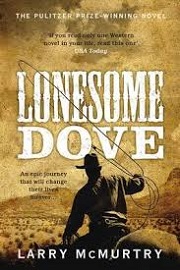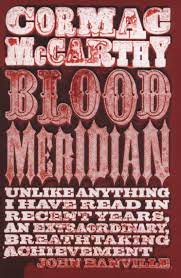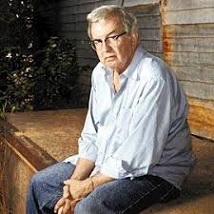
© Pan Books
So it’s farewell to the author Larry McMurtry, who passed away on March 25th at the age of 84. Here’s what I wrote on this blog about Mr McMurtry’s most famous opus after I finished reading it early last year.
The cowboy-herding, dust-churning, all-mooing-and-lowing cattle drive may not be the biggest trope in the western genre. That accolade probably belongs to the High Noon-style showdown. But it’s surely a major one.
Most famously, a cattle drive figured in the classic 1948 Howard Hawks / John Wayne western movie Red River and as late as 1972 Wayne was still herding cattle across the prairies in Mark Rydell’s The Cowboys. Elsewhere, cattle drives have been the basis for eight seasons of the western TV series Rawhide (1959-65), been subjected to revisionism in the raw-edged film The Culpepper Cattle Co (1972), been lovingly parodied in the Billy Crystal comedy City Slickers (1991) and even been reimagined in a bucolic British setting in Richard Eyre’s Singleton’s Pluck (1984). That last movie, written by Brian Glover and starring Ian Holm, told the tale of a poultry farmer who’s forced by a transport workers’ strike to walk his thousands of geese to market, all the way from Norfolk to London.
However, the above cattle drives last within the timeframes of films or TV episodes and take up no more than a couple of hours of your time. By the time you get through the 843 pages of Larry McMurtry’s Pulitzer Prize-winning novel Lonesome Dove (1985), you almost feel you’ve taken part in a cattle drive. I started reading it at the beginning of 2020 and by the time I’d finished it the most of three weeks later, I felt mentally as saddle-sore as its characters felt physically after riding from the parched plains of southern Texas to the wintry uplands of Montana. Though, like those characters when they arrived in Montana, the feeling was accompanied by a buzz of fulfilment and satisfaction too.
To be fair, the cattle drive in Lonesome Dove doesn’t take all of 843 pages. There’s a leisurely preamble whereby McMurtry sets up his characters and prepares them, and the reader, for the odyssey ahead. The characters belong to the Hat Creek Cattle Company, based at the south Texan town of the title, Lonesome Dove. The company’s proprietors are two former Texas Rangers, the garrulous, witty, warm-hearted and philosophical Augustus ‘Gus’ McCrae and the stiff, unsociable, emotionally repressed and work-driven W. F. Call. Gus reminds Call early on: “You was born in Scotland… I know they brought you over when you was still draggin’ on the tit, but that don’t make you no less a Scot.” Obviously, Call never recovered from his early exposure to Calvinism.
One day, a familiar face appears on their property. This is Jake Spoon, another ex-ranger and an old friend of theirs but someone who makes a living by gambling rather than cattle-dealing. It transpires that the charming but unprincipled and fickle Jake is on the run because he accidentally killed a man after a card game turned ugly in the Arkansas town of Fort Smith. The victim managed to be the town’s dentist, and the town’s mayor, and the brother of the town’s sheriff, July Johnson. Also, Jake brings with him stories about the opportunities offered by the newly opened-up, barely explored and still unpopulated territory of Montana. This prompts Call to gather together the company’s livestock, employees and physical possessions, such as they are, and abandon Lonesome Dove and embark on an epic journey north. The hope is that their business will prosper on Montana’s seemingly limitless grazing lands.
To bolster their supplies of cattle and horses before they leave, Call and Gus embark on a raid across the border and steal some herds from a wealthy Mexican rancher called Pedro Flores. They do this without any moral qualms, since the unscrupulous Flores does the same thing regularly in the other direction, from Mexico into Texas.
Also, they increase their crew by hiring for the drive a motley collection of cowpokes, misfits and youngsters. Jake tags along too, taking with him a young prostitute called Lorena from Lonesome Dove’s saloon, who’s fallen, temporarily at least, for his oily charms. But the workshy Jake keeps his distance from the Hat Creek gang and sets up a private camp for himself and Lorena. They quickly lose their enthusiasm for camping and the outdoors as it becomes apparent that pampered, saloon-loving cardsharp Jake is no Bear Grylls.
And so our heroes hit the trail. There follow hundreds of pages featuring sandstorms, thunderstorms, blizzards, hazardous river crossings, run-ins with bad ’uns and encounters with unfriendly wildlife such as locusts, snakes and bears. Other characters appear, including Sheriff July Johnson and his hapless deputy Roscoe, rival cattle baron Mr Wilbarger, murderous renegade Indian Blue Duck, the no-better trio of white outlaws the Suggs Brother, and feisty Clara Allen, once courted in her youth by both Gus and Jake. Clara now runs a horse ranch in Nebraska and Gus, still carrying a torch for her, intends to visit her during the drive. Larry McMurtry sub-plots furiously, with characters constantly hiving off from the drive or running into it. His characters encounter one another, part company with one another, are reunited with one another and, occasionally, kill one another.
One thing that’s striking about Lonesome Dove is the underlying randomness and arbitrariness of it all. Big events happen but often the reasons causing them to happen are fleeting whims, snap decisions or simple happenstance. The pragmatic and unimaginative Call isn’t normally taken in by Jake’s bullshit but, somehow, he falls for his tales about Montana, with the result that the Hat Creek Cattle Company uproots itself and goes. The bemused Gus tells him, “I hope it makes you happy… Driving these skinny cattle all that way is a funny way to maintain an interest in life, if you ask me.” Elsewhere, July Johnson didn’t particularly like his dead dentist / mayor brother (“Once when he had pulled a bad tooth of July’s he had charged the full fee”) and regards his death as an accident, but is bullied into going after Jake by his widowed sister-in-law.
What sets all these things in motion is the fact that in the Fort Smith saloon where Jake got himself into trouble, someone unwisely left a loaded shotgun propped against the wrong part of the wall. If this was how the West was won, Lonesome Dove suggests, it was by accident rather than design.
Similarly, the subplots often don’t resolve themselves in the way you expect, or don’t resolve themselves at all. The long-awaited showdown between Jake and July, for example, never happens because both characters get distracted by other events – Jake falling in with the Suggs brothers and soon being party to worse things than the accidental shooting of a dentist, and July learning that his dissatisfied wife has taken advantage of his absence to run away from Fort Smith and setting off in pursuit of her instead. And the expected subplot whereby the vengeful Pedro Flores pursues the Hat Creek Cattle Company to get his animals back never materialises for, soon afterwards, Call and Gus receive word that Flores has suddenly died. (“I never expected that…” “I never either, but then I don’t know why not. Mexicans don’t have no special dispensation. They die like the rest of us.”)
Meanwhile, the mid-point of the book is shocking for how the plot-threads of three characters, in whom the reader has invested a lot of time and sympathy, are abruptly terminated. I’d like to think McMurtry did this for dramatic effect, though I suspect he just realised his plotting was becoming too tangled and he needed to prune it.

©Picador
Talking of being shocking, there are times, especially when Blue Duck and the Suggs Brothers are centre-stage, when Lonesome Dove veers off into the gruelling, blood-soaked territory inhabited by another famous western novel that appeared in 1985, Cormac McCarthy’s Blood Meridian. However, despite its occasional darkness, Lonesome Dove contains much more humanity, warmth and optimism than McCarthy’s nihilistic gorefest / prose-poem.
It also isn’t afraid to evoke the conventions that were staples of the westerns of yore and I wonder how a young 21st century readership would react to some of those conventions today. The western was traditionally a genre where ‘a man’s gotta do what a man’s gotta do’ and it paid little attention to feminist sensibilities. Accordingly, some may find the character of Lorena problematic, since she starts the novel as a hard-assed grifter but steadily becomes more dependent on the men around her. First, she falls for Jake, and then she falls for Gus, who rescues her after she’s been abducted by Blue Duck. That said, the rancher Clara Allen is one of the toughest and wisest characters in the book. Near the end, she gets a chance to speak her mind to Call, somebody she’s always had a low opinion of: “You men and your promises: they’re just excuses to do what you plan to do anyway, which is leave. You think you’ve always done right – that’s your ugly pride, Mr Call… You’re a vain coward, for all your fighting. I despised you then for what you were, and I despise you now, for what you’re becoming.”
Another old Western convention that’s less palatable nowadays is that of having native Americans as the bad guys. And in Lonesome Dove, Blue Duck and his henchmen are particularly and memorably vile. But in McMurtry’s defence, I’d argue that more often the natives featured in the novel are impoverished, pitiful and dispossessed due to the remorseless encroachment of the White Man. At one point, for instance, Call donates a few of the company’s steers to a band of starving Wichita tribespeople. It’s insinuated that if people are treated cruelly, some at least will come to behave cruelly too. Interestingly, Clara shows no concern about a Sioux chief called Red Cloud who’s on the warpath in her neighbourhood because, she explains to July, her late husband behaved honourably to Red Cloud and his people once. “I know Red Cloud… Bob was good to him. They lived on our horses that hard winter we had four years ago – they couldn’t find buffalo… Bob treated them fair and we’ve never had to fear them.”
Also, though Call and Gus’s earlier line of work as rangers frequently involved them killing native Americans who violently objected to the US government’s policies towards them, Gus at least questions the wisdom of what they did. This is especially so now that the White Man’s ‘civilisation’ – as epitomised by ‘the bankers’ – is moving in and taking over. “Does it ever occur to you that everything we done was probably a mistake…?” he asks Call. “Me and you done our work too well. We killed off most of the people that made this country interesting to begin with.”
Later, he speculates that a time will come when the bankers will need to kill the likes of him off too. Which, in a roundabout way, makes this densely plotted and ruggedly entertaining novel a forerunner to David Mackenzie’s excellent modern-day western movie about cowboys versus bankers, 2016’s Hell or High Water.

From facebook.com
